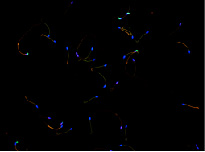Successful sperm cryopreservation in Egyptian spiny mice Acomys cahirinus
Jarrod McKenna A B , Sally Catt A , Mulyoto Pangestu A and Peter Temple-Smith A
A B , Sally Catt A , Mulyoto Pangestu A and Peter Temple-Smith A
A Education Program in Reproduction & Development, Department of Obstetrics & Gynaecology, School of Clinical Sciences, Monash University, Victoria, Australia.
B Corresponding author. Email: jarrod.mckenna@monash.edu
Reproduction, Fertility and Development 32(16) 1293-1297 https://doi.org/10.1071/RD20115
Submitted: 27 April 2020 Accepted: 25 August 2020 Published: 16 September 2020
Abstract
The menstruating Egyptian spiny mouse has recently been proposed as a new animal model for reproductive health research. Unfortunately, little is known about reproduction in males. This study compared several characteristics of sperm function before and after cryopreservation. Epididymal spermatozoa were cryopreserved in different concentrations of raffinose and skim milk and tested for motility and membrane integrity (Experiment 1). Further evaluations of motility, plasma membrane and acrosome integrity, mitochondrial membrane potential and DNA integrity were conducted with the addition of l-glutamine to the extender (Experiment 2). The results show that, following cryopreservation, motility and membrane integrity were reduced, but were better maintained in the presence of l-glutamine (P < 0.05). Moreover, although all sperm parameters were significantly reduced following cryopreservation (P < 0.05), most cryopreserved spermatozoa retained acrosome, membrane and DNA integrity while also maintaining motility and mitochondrial membrane potential. This study provides a new step towards the development of assisted reproductive techniques and archiving the important genetics of the world’s only known menstruating rodent.

Keywords: Acomys cahirinus, acrosome reaction, cryopreservation, DNA integrity, Egyptian spiny mice, fluorescence microscopy, membrane integrity, mitochondrial potential, sperm, spermatozoa.
References
Aitken, R. J., Smith, T. B., Jobling, M. S., Baker, M. A., and De Iuliis, G. N. (2014). Oxidative stress and male reproductive health. Asian J. Androl. 16, 31–38.| Oxidative stress and male reproductive health.Crossref | GoogleScholarGoogle Scholar | 24369131PubMed |
Bellofiore, N., Ellery, S. J., Mamrot, J., Walker, D., Temple-Smith, P., and Dickinson, H. (2017). First evidence of a menstruating rodent: the spiny mouse (Acomys cahirinus). Am. J. Obstet. Gynecol. 216, 40.e1–40.e11.
| First evidence of a menstruating rodent: the spiny mouse (Acomys cahirinus).Crossref | GoogleScholarGoogle Scholar |
Brunjes, P. C. (1990). The precocial mouse, Acomys cahirinus. Psychobiology 18, 339–350.
Dickinson, H., and Walker, D. (2007). Managing a colony of spiny mice (Acomys cahirinus) for perinatal research. ANZCCART News 20, 4–11.
Emera, D., Romero, R., and Wagner, G. (2012). The evolution of menstruation: a new model for genetic assimilation. BioEssays 34, 26–35.
| The evolution of menstruation: a new model for genetic assimilation.Crossref | GoogleScholarGoogle Scholar | 22057551PubMed |
Gharagozloo, P., and Aitken, R. J. (2011). The role of sperm oxidative stress in male infertility and the significance of oral antioxidant therapy. Hum. Reprod. 26, 1628–1640.
| The role of sperm oxidative stress in male infertility and the significance of oral antioxidant therapy.Crossref | GoogleScholarGoogle Scholar | 21546386PubMed |
Haughton, C. L., Gawriluk, T. R., and Seifert, A. W. (2016). The biology and husbandry of the African spiny mouse (Acomys cahirinus) and the research uses of a laboratory colony. J. Am. Assoc. Lab. Anim. Sci. 55, 9–17.
| 26817973PubMed |
Koshimoto, C., Watanabe, D., Shinohara, A., and Morita, T. (2009). Maintenance of fertility in cryopreserved Indian gerbil (Tatera indica) spermatozoa. Cryobiology 58, 303–307.
| Maintenance of fertility in cryopreserved Indian gerbil (Tatera indica) spermatozoa.Crossref | GoogleScholarGoogle Scholar | 19268658PubMed |
Mochida, K., Hasegawa, A., Otaka, N., Hama, D., Furuya, T., Yamaguchi, M., Ichikawa, E., Ijuin, M., Taguma, K., and Hashimoto, M. (2014). Devising assisted reproductive technologies for wild-derived strains of mice: 37 strains from five subspecies of Mus musculus. PLoS One 9, e114305.
| Devising assisted reproductive technologies for wild-derived strains of mice: 37 strains from five subspecies of Mus musculus.Crossref | GoogleScholarGoogle Scholar | 25479253PubMed |
Okuyama, M., Isogai, S., Saga, M., Hamada, H., and Ogawa, S. (1990). In vitro fertilization (IVF) and artificial insemination (AI) by cryopreserved spermatozoa in mouse. J. Fertil. Implant. 7, 116–119.
Sato, M., Nishino, N., and Totsukawa, K. (2000). Cryopreservation of Mongolian gerbil spermatozoa. J. Mamm. Ova Res. 17, 115–119.
| Cryopreservation of Mongolian gerbil spermatozoa.Crossref | GoogleScholarGoogle Scholar |
Shaw, J. M., and Jones, G. M. (2003). Terminology associated with vitrification and other cryopreservation procedures for oocytes and embryos. Hum. Reprod. Update 9, 583–605.
| Terminology associated with vitrification and other cryopreservation procedures for oocytes and embryos.Crossref | GoogleScholarGoogle Scholar | 14714593PubMed |
Sztein, J. M., Noble, K., Farley, J. S., and Mobraaten, L. E. (2001). Comparison of permeating and nonpermeating cryoprotectants for mouse sperm cryopreservation. Cryobiology 42, 28–39.
| Comparison of permeating and nonpermeating cryoprotectants for mouse sperm cryopreservation.Crossref | GoogleScholarGoogle Scholar | 11336487PubMed |
Taft, R. (2017). Mouse sperm cryopreservation using cryoprotectant containing monothioglycerol (MTG). Cold Spring Harb Protoc 2017, prot094490.
| Mouse sperm cryopreservation using cryoprotectant containing monothioglycerol (MTG).Crossref | GoogleScholarGoogle Scholar | 29093204PubMed |
Takeo, T., and Nakagata, N. (2010). Combination medium of cryoprotective agents containing l-glutamine and methyl-β-cyclodextrin in a preincubation medium yields a high fertilization rate for cryopreserved C57BL/6J mouse sperm. Lab. Anim. 44, 132–137.
| Combination medium of cryoprotective agents containing l-glutamine and methyl-β-cyclodextrin in a preincubation medium yields a high fertilization rate for cryopreserved C57BL/6J mouse sperm.Crossref | GoogleScholarGoogle Scholar | 20357317PubMed |


